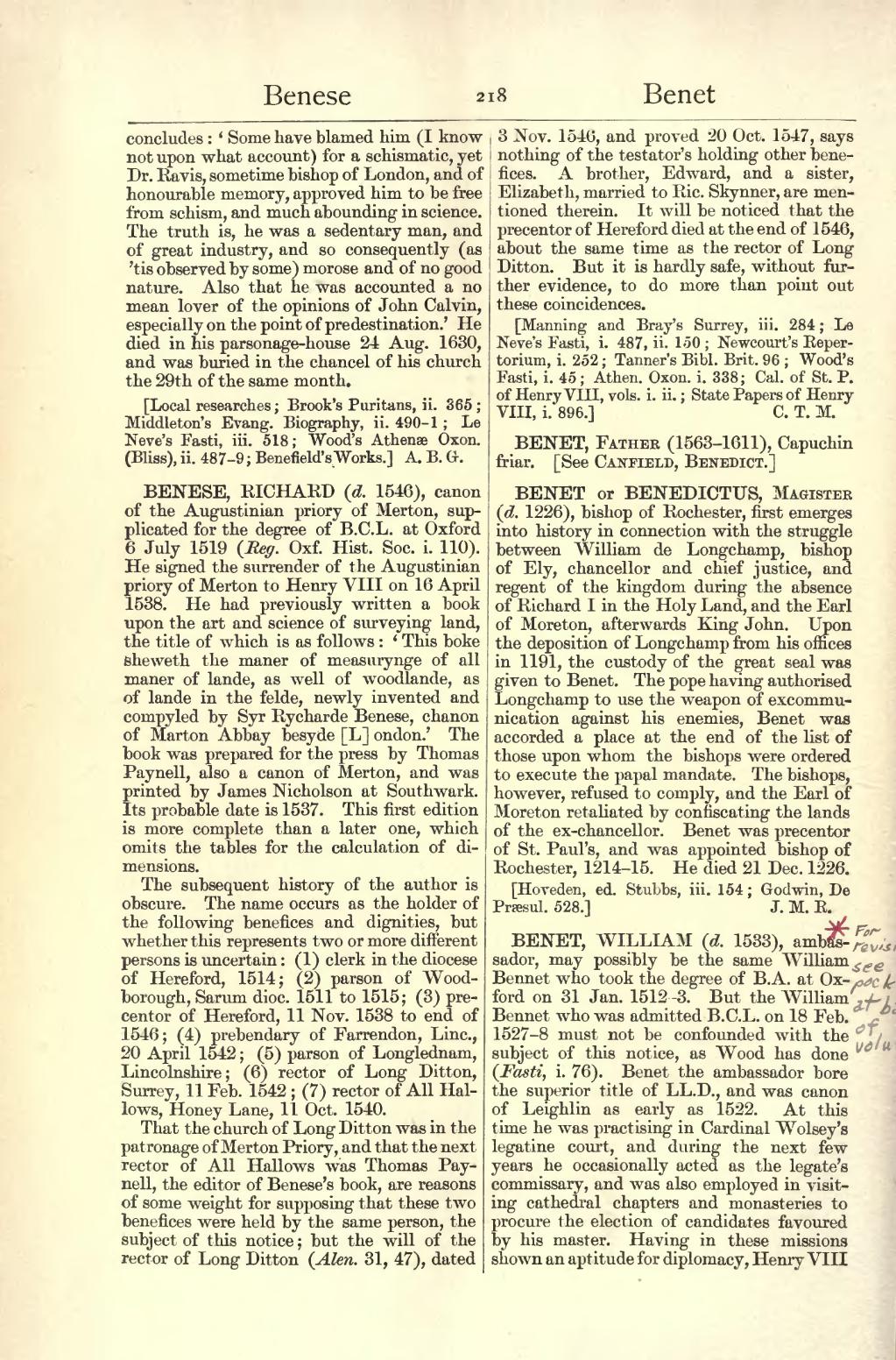concludes: 'Some have blamed him (I know not upon what account) for a schismatic, yet Dr. Ravis, sometime bishop of London, and of honourable memory, approved him to be free from schism, and much abounding in science. The truth is, he was a sedentary man, and of great industry, and so consequently (as 'tis observed by some) morose and of no good nature. Also that he was accounted a no mean lover of the opinions of John Calvin, especially on the point of predestination.' He died in his parsonage-house 24 Aug. 1630, and was buried in the chancel of his church the 29th of the same month.
[Local researches; Brook's Puritans, ii. 865; Middleton's Evang. Biography, ii. 490-1; Le Neve's Fasti, iii. 618; Wood's Athenae Oxon. (Bliss), ii. 487-9; Benefield's.Works.]
BENESE, RICHARD (d. 1546), canon
of the Augustinian priory of Merton, supplicated
for the degree of B.C.L. at Oxford
6 July 1619 (Reg. Oxf. Hist. Soc. i. 110).
He signed the surrender of the Augustinian
priory of Merton to Henry VIII on 16 April
1538. He had previously written a book
upon the art and science of surveying land,
the title of which is as follows : 'This boke
sheweth the maner of measurynge of all
maner of lande, as well of woodlande, as
of lande in the felde, newly invented and
compyled by Syr Rycharde Benese, chanon
of Marton Abbay besyde [L]ondon.' The
book was prepared for the press by Thomas
Paynell, also a canon of Merton, and was
printed by James Nicholson at Southwark.
Its probable date is 1537. This first edition
is more complete than a later one, which
omits the tables for the calculation of dimensions.
The subsequent history of the author is obscure. The name occurs as the holder of the following benefices and dignities, but whether this represents two or more different persons is uncertain: (1 ) clerk in the diocese of Hereford, 1514; (2) parson of Woodborough,Sarum dioc. 1511 to 1515; (3) precentor of Hereford, 11 Nov. 1538 to end of 1546; (4) prebendary of Farrendon, Linc., 20 April 1542; (5) parson of Longlednam, Lincolnshire; (6) rector of Long Ditton, Surrey, 11 Feb. 1542; (7) rector of All Hallows, Honey Lane, 11 Oct. 1540.
That the church of Long Ditton was in the patronage of Merton Priory, and that the next rector of All Hallows was Thomas Paynell,the editor of Benese's book, are reasons of some weight for supposing that these two benefices were held by the same person, the subject of this notice; but the will of the rector of Long Ditton (Alen. 31, 47), dated3 Nov. 1546, and proved 20 Oct. 1547, says nothing of the testator's holding other benefices. A brother, Edward, and a sister,Elizabeth, married to Ric. Skynner, are mentioned therein. It will be noticed that the precentor of Hereford died at the end of 1546,about the same time as the rector of Long Ditton. But it is hardly safe, without further evidence, to do more than point out these coincidences.
[Manning and Bray's Surrey, iii. 284; Le Neve's Fasti, i. 487, ii. 150; Newcourt's Repertorium, i. 252; Tanner's Bibl. Brit. 96; Wood's Fasti, i. 45; Athen. Oxon. i. 338; Cal. of St. P. of Henry VIII, vols. i. ii.; State Papers of Henry VIII, i. 896.]
BENET, Father (1563–1611), Capuchin friar. [See Canfield, Benedict.]
BENET or BENEDICTUS, Magister (d. 1226), bishop of Rochester, first emerges into history in connection with the struggle between William de Longchamp, bishop of Ely, chancellor and chief justice, and regent of the kingdom during the absence of Richard I in the Holy Land, and the Earl of Moreton, afterwards King John. Upon the deposition of Longchamp from his offices in 1191, the custody of the great seal was given to Benet. The pope having authorised Longchamp to use the weapon of excommunication against his enemies, Benet was accorded a place at the end of the list of those upon whom the bishops were ordered to execute the papal mandate. The bishops, however, refused to comply, and the Earl of Moreton retaliated by confiscating the lands of the ex-chancellor. Benet was precentor of St. Paul's, and was appointed bishop of Rochester, 1214-15. He died 21 Dec. 1226.
[Hoveden, ed. Stubbs, iii. 154; Godwin, De Præsul. 528.]
BENET, WILLIAM (d. 1533), ambassador, may possibly be the same William Bennet who took the degree of B.A. at Oxford on 31 Jan. 1512-3. But the William Bennet who was admitted B.C.L. on 18 Feb. 1527-8 must not be confounded with the subject of this notice, as Wood has done (Fasti i. 76). Benet the ambassador bore the superior title of LL.D., and was canon of Leighlin as early as 1522. At this time he was practising in Cardinal Wolsey's legatine court, and during the next few years he occasionally acted as the legate's commissary, and was also employed in visiting cathedral chapters and monasteries to procure the election of candidates favoured by his master. Having in these missions shown an aptitude for diplomacy, Henry VIII
